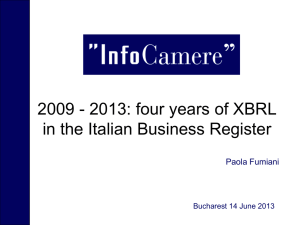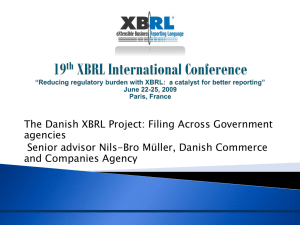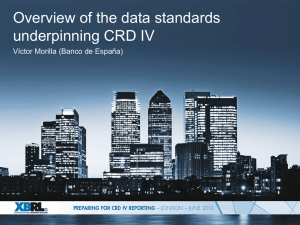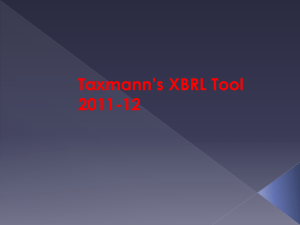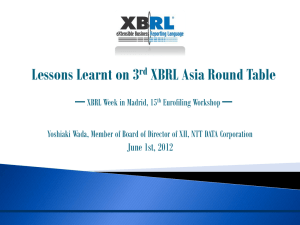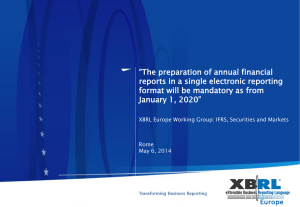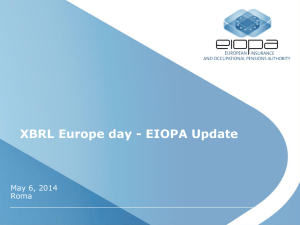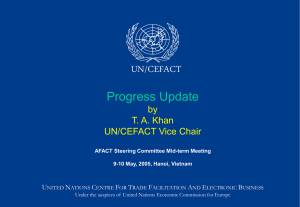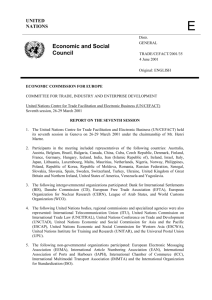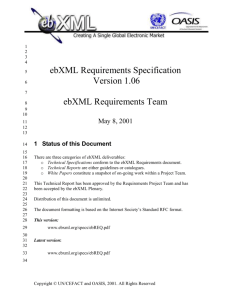How eBusiness Standardization can help XBRL
advertisement
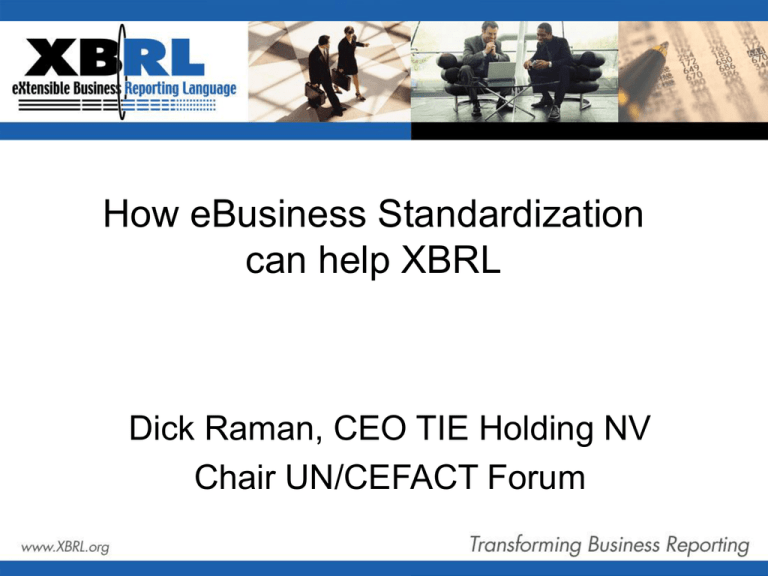
How eBusiness Standardization can help XBRL Dick Raman, CEO TIE Holding NV Chair UN/CEFACT Forum Agenda • • • • • • What is UN/CEFACT? What is ebXML? Why is TIE involved? Will XBRL be successful? Issues for XBRL Challenges for XBRL UN/CEFACT SIMPLE, TRANSPARENT AND EFFECTIVE PROCESSES FOR GLOBAL BUSINESS. UN/CEFACT Plenary >250 delegates (Governments, Global Organizations) UN/CEFACT Bureau UN/ECE Secretariat UN/CEFACT Rapporteurs UN/CEFACT Forum Technology Syntax Business Documents Legal UN/CEFACT Responsibilities • Trade facilitation – Simplification of global trade – Between Governments and Companies – Using eBusiness • Producing Global standards – UN/Layout Key (UNeDocs) – UN/EDIFACT – ebXML (in cooperation with OASIS) • • • • The Multi-Enterprise cCommerce Framework Interoperable, open, global, B2B ‘standard’ Complex solution and SME support Leveraging existing technologies and standards • Integration of business processes: – By electronic means – Independent of the technical solution. – Allowing business processes and technologies to evolve independently ebXML Focus Areas • Semantic Framework – Meta-model for defining business process – A set of re-useable core components (common business semantics) • Infrastructure – Transport, Routing, Packaging – Collaboration Protocol Profiles/Agreements – Shared repository network • company profiles, business process models and related message structures Architecture Core Components • Designed to capture: • Business concepts (commonality) • Relationship between business concepts • Individual pieces (objects) of business information in a context • Format: • • • • Syntax Neutral Can contain other core components Uniquely identified (GUid) Facilitate multi-lingual support Too many data standards agXML XAML cXML IATA OTA Rosettanet CIDX GCI HL7 xCat Bolero SMDG EHD GML SWIFT PIDX xCBL UBL VICS Togaf UNe Doc HRXML BSML Opent rans Acord Econstruct CAT XML All have different data elements! UN/CEFACT Core Components Reconciliation Of Data Elements UN/CEFACT Core Component Library 200? 2004 2002 verticals 1999 Existing Standards eGov XML X12 SGML XML EDIFACT Etc. Standardization of Semantics • Groups of people can decide on semantics – But they are not interoperable with other groups • A Global Top-Down Process is required – To capture semantics – To structure/harmonize them – In order to simplify the interactions • UN/CEFACT was set up to do this – Commitment at the highest level • It takes many years UBL • First glimpse of what ebXML looks like • They took the short-cut: – Syntax Specific – Limited reach • Good eBusiness solution for the short term • UN/CEFACT and OASIS back together • To guarantee migration to ebXML Transport Structure Why is TIE involved? • TIE is a B2Bi Software Company • TIE is a Public Company – Must report in IFRS starting 2005 – Full Integration of IFRS in Accounting System – Quarterly/Annual reports in XBRL • TIE is experienced in eBusiness Standardization • TIE adapted its eBusiness tools for XBRL • TIE has tools available for the best infrastructure for XBRL (ebMS) • TIE has partnerships in place to offer full implementation & support. Will XBRL be successful? • • • • All major players support XBRL IFRS is Mandatory in Europe Rest of the world is following Dutch government first to enforce – 25% cost reduction (EUR 3 bn) – mandatory reporting in XBRL • There is no competing standard • No semantic discussions – when XBRL is based on IFRS Semantics in eBusiness • Are the real issue • Not the physical transport – From diskette to webService • XML is designed to be ‘eXtensible’ – That is its strong point • For B2Bi you need very explicit agreements – Technical issues – easy (20%) – Business issues – difficult (80%) Semantics in XBRL • XBRL is like eBusiness – Interactions between different organizations – Within an organization semantics are no issue • IFRS provides a strong (legal) framework for the semantics of XBRL – US/GAAP does too, but that is another discussion – IASB provides the semantics • Building your own Taxonomy – – – – Is a nice intellectual exercise Useful to know what your extension will be Should never be used in practice This leads to a semantic nightmare Issues for XBRL • Organization of/Agreement on: – Maintenance of the standard • IFRS, XBRL Intl, UN/CEFACT (TBG12) – Infrastructure for messaging • ebXML Messaging (ebMS) – Certification of Software/Messages • Many options – Codelists • UN/CEFACT, ISO eReporting is NOT eBusiness • Use XBRL only for reporting! – Using it for eBusiness = Semantic Problem – There are better standards already available – Concentrate efforts on getting XBRL in the mainstream – There is a lot to be done! • XBRL GL is already one step too far – Capturing transactions = semantic problem • Invoices in XBRL – Will really lead to confusion and are a duplication of effort Getting XBRL in the Mainstream • XBRL is in the Early Stages – Academic, Experimental • • • • • • Create Awareness (Financial Press) Show the Business benefits Define clear implementation path Message Implementation Guidelines Parties that benefit, play leading role Positive/Negative encouragements In eBusiness, we’ve been there, done that! Challenges for XBRL • • • • ‘Crossing the Chasm’ Maturing the standardization process Re-use what is there…not re-invent the wheel Establish relationships with other (eBusiness) standardization organizations: – UN/CEFACT, OASIS • Join the ‘ISO-IEC-ITU-UN/ECE MoU’ • Defining the Road-map Contact Info ebXML web site: http://www.ebXML.org UN/CEFACT web site: http://www.uncefact.org TIE XBRL web site: http://xbrl.TIEglobal.com Corporate Website: http://www.TIEglobal.com E-mail: Dick.Raman@TIEglobal.com


